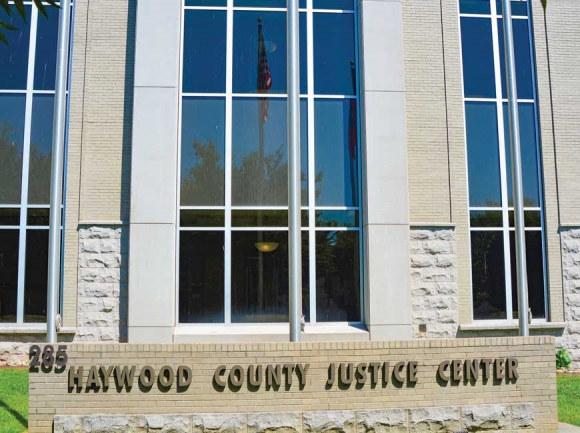Future of Haywood lynching monument becoming clear
 The Haywood County Justice Center has emerged as the preferred location for a controversial monument. Cory Vaillancourt photo
The Haywood County Justice Center has emerged as the preferred location for a controversial monument. Cory Vaillancourt photo
While much of the nation is talking about removing monuments, the discussion in one Western North Carolina county is also about installing them — and that discussion is no less contentious.
“I think this monument should be located in the lobby of the Justice Center,” said Kevin Ensley, chairman of the Haywood County Board of Commissioners. “Since Mr. Ratcliff’s Fifth and Fourteenth Amendment rights were violated and justice was not served, it would be a reminder to those who enter that justice should always be paramount in our nation.”
By early 1900, George Ratcliff, a 25-year-old Black man, had worked for Clyde-area farmer Matthias Holland for about a decade.
That all came to a quick end on March 3 when Ratcliff was accused of sexually assaulting Holland’s 10-year-old granddaughter. According to a contemporary story in the Goldsboro Headlight, Holland’s wife heard the girl’s screams and attempted to intervene.
Ratcliff fled on foot, pursued by the girl’s uncle, Joe Holland. Another uncle was dispatched to Clyde to spread the word and to wire Canton with a similar warning.
A posse formed and eventually located Ratcliff, took him into custody and brought him to Clyde; prominent local attorney and politician D.I.L. Smathers was charged with Ratcliff’s safekeeping, and appointed eight men to guard Ratcliff through the night.
Related Items
The next day, Ratcliff was escorted to Waynesville’s jail. Late that night, around 1 a.m., more than 50 people with concealed faces arrived at the jail, demanding to see Ratcliff.
Haywood County Sheriff William J. Haynes, who lived at the jail as was common at the time, refused the crowd’s demands. The masked mob broke down the exterior door, and again demanded Haynes take them to Ratcliff. Haynes again refused.
The mob then broke down the interior door, and made it to Ratcliff’s cell, demanding that a deputy named Henson give them the keys to Ratcliff’s cell. Henson refused, as Haynes went for help that never came.
Unable to enter Ratcliff’s cell, the mob wouldn’t be denied — according to a story in the Asheville-Citizen, Ratcliff was shot more than 40 times, through the bars of his cell. His cellmate was, miraculously, unharmed.
The next day, the headline in the Citizen loudly proclaimed “Another Brute Pays Penalty.”
Without trial, without jury, without any of the benefits of due process, George Ratcliff became another one of more than 6,500 people — Black, white and Native American — to be lynched between 1877 and 1950 according to the Montgomery, Alabama-based Equal Justice Institute.
In 2018, almost 120 years after Ratcliff’s lynching in Waynesville, the EJI opened the National Memorial for Peace and Justice in Montgomery.
Part of the memorial is a large, open-air pavilion. From the roof of that pavilion hang more than 800 rectangular steel boxes, roughly analogous in size and shape to coffins.
Each box bears the name of a U.S. county where a documented lynching occurred. Haywood County, and Ratcliff, are represented there, as are 64 other North Carolina counties, including Buncombe, Cherokee and Macon.
Outside the pavilion, in an adjacent 6-acre park, are identical replicas of each of the columns hanging in the pavilion, even more evocative of coffins as they lay on the grassy ground. They’re only there temporarily, though — the EJI wants each county to take theirs home to their communities and erect them in a place of prominence for all to see.
The EJI won’t simply release the monument to anyone who expresses a desire to erect it in their county, however. The group wants large-scale community buy-in, from nonprofits, businesses and local governments.
In February 2019, the Haywood Branch of the National Association for the Advancement of Colored People took up the task of determining what, if anything, should be done with the monument.
Rev. Walter Bryson, head of the Haywood NAACP, related the story of Ratliff and the EJI to members. A month later, more discussion on the issue was held, and opinions were deeply divided.
Some Black members of the group feared that the monument would stir up trouble for the Black community in Waynesville. Other Black members disagreed. Some white members of the group feared that the monument would stir up trouble for the Black community in Waynesville. Other white members disagreed.
At the time, Haywood resident John Woods summed up the arguments on both sides of the issue.
“I have two thoughts. One of them is, absolutely, to take a stance on education and honesty and owning our history, we should bring it back,” he told SMN on March 27, 2019. “But sitting in the meeting today as a white male with all of my privilege, I can imagine how bringing that back could cause people of color harm and put them at peril. I don’t think that’s a deal-breaker, a reason not to do it, but it’s one of those things where I’m reminded about the issue of white privilege — it’s not going to cause me any difficulty to bring it back.”

Monuments on the Historic Haywood Courthouse lawn commemorate the county’s veterans. Cory Vaillancourt photo
That May, members of the Haywood NAACP embarked on a bus trip to visit several Civil Rights-era sites in Alabama, including Ratcliff’s monuments. The long ride would give the group time to talk, both on the way there, and on the way back.
The trip, according to NAACP member Katherine Bartel, resulted in the group largely supporting the monument’s relocation to Haywood County, however there was still widespread disagreement as to where, exactly, it should go.
One option was a new park being constructed in Waynesville’s historic African American community off Pigeon Street. That site has drawbacks, however, in that it’s a bit off the beaten path and unlikely ever to become a destination for tourists.
Another option was to put it on the lawn of the Historic Haywood Courthouse, in downtown Waynesville. That site, too, has drawbacks in that the only monuments there commemorate Haywood County’s veterans — including Confederates.
There wasn’t much movement on the issue throughout the rest of 2019, or during the first few months of 2020. Now, the conversation has taken on a new urgency in light of monuments across the country being removed by governments, or torn down by protestors.
The May 25 killing of Minneapolis man George Floyd at the hands of Minneapolis police sparked protests over police brutality that quickly evolved to include institutional racism, and then evolved again into the role of monuments — specifically Confederate monuments — in reinforcing white supremacy.
Two weeks ago, Asheville voted to remove two Confederate monuments and form a study commission on removing a third. Black Lives Matter demonstrations have since spread across the nation, moving from large urban areas to small towns like Franklin and Sylva.
Although events in Western North Carolina have been peaceful, internet fearmongering and local suspicion resulted in large contingencies showing up to “guard” monuments in those towns. Petitions have been circulated in both places, calling for them to stay, and to go.
Persuasive and passionate arguments abound on all sides, but as that discussion continues, so does the discussion over what to do about George Ratcliff.
“I would have been very happy to have lived my life and never heard about the heinous crime he was accused of,” said Tommy Long, a Haywood County commissioner who lives not far from where the alleged crime took place. “I would have been fine never knowing of the angry mob who shot him in the jail. It stirred up raw emotions in me.”
Long said he was handed newspaper articles by descendants of the Holland girl, proving that old wounds still run deep in rural Haywood County and that the wounds, in this case, aren’t really that old.
“They haven’t forgotten,” he said. “Raw emotions that had died down were again stirred up.”
Regardless of Ratcliff’s guilt — or lack thereof, as the true circumstances of his alleged crime can now never be proven — his extrajudicial murder while in police custody was exactly the type of behavior that in 1900 might be described as “just the way things go,” but today sparks sometimes-violent conflict.
“He was denied a fair trial and due process under the law. It was wrong. I agree that a good place would be the justice center as a reminder that Justice is to be served,” Long said.
Commissioner Brandon Rogers, who like Long lives not far from where the events transpired, agrees with the position taken by Ensley both in the 2019 SMN story, and today.
“Commissioner Ensley has stated in the past that he feels such a marker should be placed in the Justice Center and I would tend to agree,” Rogers said. “Unfortunately Mr. Ratcliff didn’t have a chance for justice to be served therefore it would be the proper place for such a marker.”
Commissioner Mark Pless also agreed with the Justice Center location. Kirk Kirkpatrick, an attorney by trade and longtime Haywood commissioner, didn’t take a position on the monument but did concede that Ratliff was denied his constitutional rights.
“Certainly, to lynch a man without a trial is failure to follow due process under the law of this country and his rights were violated,” Kirkpatrick said. “Many other people’s rights, white, Black, Asian or Hispanic, have also been violated. Singling Mr. Ratcliff out to me promotes an idea that lynching was limited to Black people when in fact that is not the truth.”
Regardless, it now appears that momentum is building and that one day, perhaps soon, the monument will make its debut, somewhere in Haywood County.
“Mob rule has no place in America,” Ensley said. “This marker would be a powerful reminder of that.









